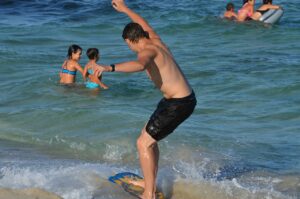Skimboarding is a board sport similar to surfing, but on a smaller scale. A skim board is used to glide across the water surface as the oncoming breaking waves approach and return to land. Skim boarding is something I’ll show you how to do.
Skimboarding began in the late 1920s when Laguna Beach lifeguards attempted to ride the waves of the beach but found they were not deep enough.
It’s a wonderful sports activity for people who don’t want to deal with large waves or can’t afford a surfboard, but don’t want to drive far for some beach action.
Easiest Steps to Learn Skimboarding
Flatland and wave-riding skimboarding are the two types of skimboarding. Flatland skimboarding is a good place to begin learning how to skimboard. We’ll go through each procedure step by step so you can learn to skimboard as quickly as possible.
Step 1: Find a good practice location and a skimboard
It’s best to start learning the fundamentals on dry sand. However, if dry sand isn’t accessible, you may practice on wet grass. Instead of investing in a pricey carbon fiber skateboard, a simple flat wooden skimboard would do the trick for training.
Step 2: Learn how to hold the board
To begin, you must first determine your dominant leg. If you’re right-footed, hold the board with your left hand in the front and right hand in the back; otherwise, just match this posture. Maintain a well-balanced and peaceful posture while holding the board so that you may feel at ease.
Step 3: Run-up and board placement
You must run at the speed you want to fall on the board. That being said, if you run up too slowly, you may acquire little momentum and have the skimboard travel a relatively short distance. Moving too fast also has the potential to cause loss of balance.
While running up, find a speed that works for you and place the board on the ground with your arm swing. Don’t drop it flat or float it; keep it low. It will also aid in the board’s gain of momentum.
Step 4: Leg position and stance
We must first understand the stance and placement of our legs before moving on to the skimming. The leading leg should be positioned behind the board, while the trailing leg should be in front.
The dominant leg is placed on the board first, followed by the second leg. The ground may be pushed with the 2nd leg to gain some momentum, but this is optional. To keep your equilibrium, you’ll want to maintain a slightly bent stance as you get on the board.
Step 5: Skimming
You want to make sure you’re coming onto the board rather than leaping on it when you first get on the board. Jumping on the board can significantly reduce the momentum of the board, making you fall over.
Also, as the board is going straight, if you get on it from the side, it will lose momentum and you may end up slipping.
If you want to use the same technique, run up from behind and ride across the surface for a nice smooth glide.
That’s all there is to it! That concludes our list of essential pointers for learning how to skimboard.
Tips to Learn How to Skimboard Easily:
It takes a long time to learn anything. However, some hints and methods can assist you in learning the subject faster and more easily.
- If you’re just getting started on dry sand, applying some speed wax to the board will make it more slippery.
- If you’re used to dry sand, try wet sand with a thin coating of water.
- Make sure to ride the waves near the coast, and time your run up for it.
- To get a better balance for performing tricks and turns, bend down more into a semi-crouch position.
Related Questions: (FAQ)
What if I don’t have a beach nearby to skim?
Skim in shallow streams or moist grass. They’re both ideal skimming surfaces. Make sure you don’t go too far into the river since rivers aren’t as rough as the sea or ocean.
How to choose the right wave and timing?
If you’re looking to do flatland skimming, be patient and wait for the wave to break. Start your run up as soon as the wave breaks, then start skimming once it crests again. When it comes to wave-riding skimming, the optimum wave is one that is neither too powerful nor too feeble and will break near the beach. Start your run up as soon as the wave begins to rise; this way, you’ll be able to ride it at its peak.
I see some people kicking sand on the board. Why is that?
It’s to add extra weight to the board. On windy days, it may be difficult to manage the board as it is dropped. As a result, some surfers kick sand on the board to increase its weight and make it easier to control during the wind.
Conclosion
Skimboarding is a wonderful sport for individuals who don’t have the ability to surf and wish to experience something comparable. This is a fantastic form of exercise that provides your body with a great workout while also being enjoyable.
Make sure to know how to swim before beginning skimboarding, and wear some safety gear to safeguard your head, ankles, and knee when you’re learning, since it may cause significant injury if done incorrectly. It’s a fantastic way to spend your time at the beach, so go buy yourself a skim board now and get started learning how to skim!
